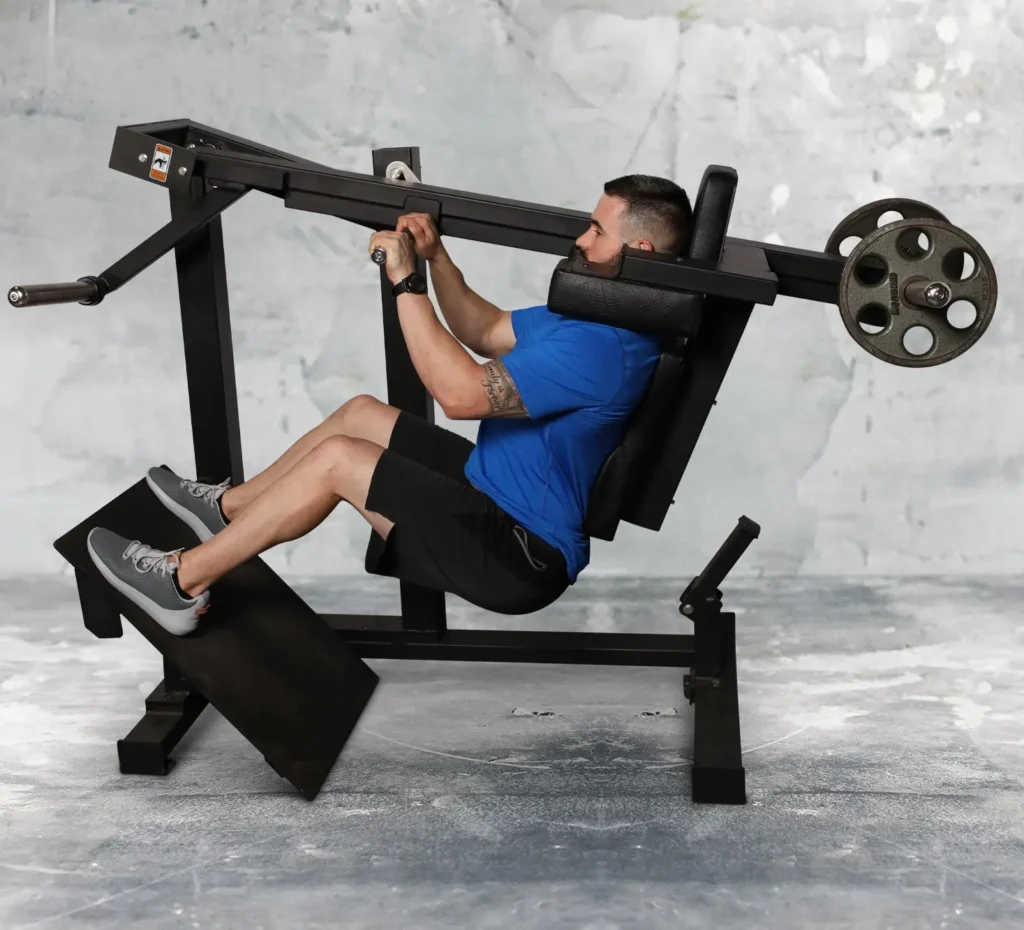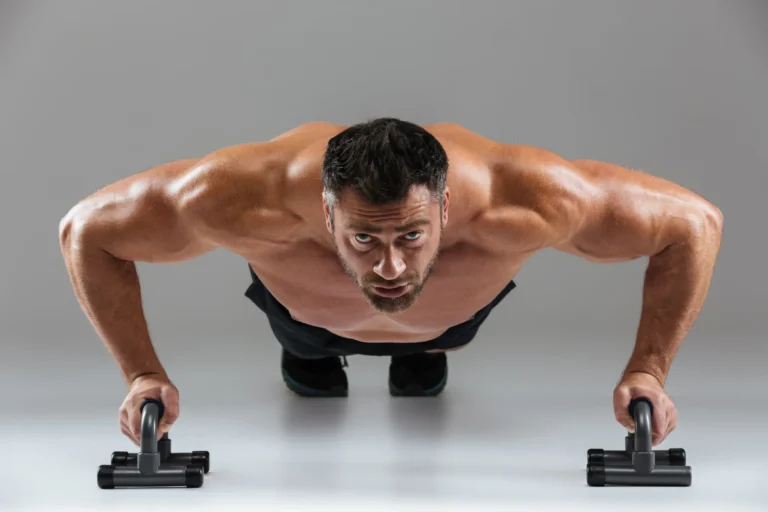Ready to take your lower body workouts to the next level? Try the Pendulum Squat! This dynamic exercise, also known as the Bulgarian Split Squat or Single Leg Squat, offers a powerful tool for building strength, improving stability, and sculpting your legs. Notably, it has captivated the attention of fitness enthusiasts, athletes, and even physical therapists globally. Indeed, this unique exercise is more than just a fad – it’s a powerful tool for unlocking deeper squats, maximized muscle engagement, and a stronger, more resilient you.
Understand What is Pendulum Squat: A Controlled Path to Lower Body Gains
The pendulum squat, a distinct variation of weighted squats, offers a novel approach to sculpting the lower body. Unlike traditional squats, the pendulum squat employs a unique machine designed to create a controlled pendulum-like motion. Consequently, this machine guides users to maintain an upright posture while experiencing the resistance of weighted squats, providing a targeted workout for the quadriceps, hamstrings, and glutes.
Why Pendulum Squats Deserve a Spot in Your Workout Routine
Research suggests that the pendulum squat is particularly effective in engaging and activating lower body muscles due to its controlled movement pattern. Compared to free-weight squats, the machine-guided motion reduces the risk of improper form, making it accessible for individuals at various fitness levels. Therefore, the pendulum squat is not just a variation; it’s a tool for precision and efficiency in lower body strength training.
Mastering the Perfect Pendulum Squat: Technique is Key
Step 1: Adjust the Pendulum Squat Machine for Optimal Form And Muscle Engagement
Find Your Sweet Spot

Adjust the machine’s seat height so your knees form a 90-degree angle when your feet are flat on the platform. This optimizes leverage and effectively helps target the quadriceps, hamstrings, and glutes. Therefore, think sculpted legs and a robust posterior chain!
Shoulder-Width Stance For Stability
Place your feet hip-width apart, ensuring toes point slightly outward for natural hip alignment. This stance promotes knee stability and reduces the risk of injury, a key concern for many fitness enthusiasts searching for low-impact leg exercises.
Step 2: Grip The Handles For Control And Core Activation
Grab Those Handles
Firmly grasp the handles on either side of the machine. Not only do they provide stability throughout the movement, but they also help you maintain an upright torso. This is a crucial aspect of proper form, often emphasized when comparing pendulum squats to barbell squats.
Engage Your Core
As you grip the handles, brace your core muscles. This creates a solid foundation for the movement, protecting your spine and maximizing core activation. Remember, a strong core is essential for overall fitness and can even help alleviate lower back pain, a common concern many readers might have.
Step 3: Embrace The Pendulum And Flow With Control.
Let The Machine Guide You
As you descend, allow the machine’s pendulum-like motion to guide your squat. Rather than forcing the movement, focus on a controlled descent to enhance targeted muscle engagement and reduce joint stress. Consequently, this controlled motion becomes a standout feature of the pendulum squat, often praised for its beginner-friendliness compared to free weights.
Think “Deep Squat,” Not Just “Down”
Aim to reach a deep squat position where your glutes nearly touch the ground. This full range of motion maximizes muscle activation and builds deeper, stronger squats, a coveted goal for many fitness enthusiasts searching for glute strengthening exercises and hamstring exercises.
Step 4: Maintain Proper Form For Safety And Efficiency.
A Neutral Spine Is Key
Keep your back straight and core engaged throughout the movement to maintain a neutral spine. This protects your lower back and ensures you’re targeting the intended muscles, not putting unnecessary strain on your spine. Furthermore, proper form is crucial to avoid injury and fully benefit from the pendulum squat.
Knees Aligned For Optimal Tracking
As you squat, ensure your knees track over your toes and don’t cave inward. This proper knee alignment minimizes joint stress and promotes safe, effective exercise.
Step 5: Full Range Of Motion For Maximum Gains
Go Deep, Reap The Rewards From Pendulum Squat
Don’t shortchange yourself! Aim for a full range of motion by reaching your glutes towards the ground at the bottom of the squat. This deeper squat activates more muscle fibres, increasing strength, flexibility, and sculpted glutes, a significant perk for those seeking a well-rounded lower-body workout. Remember, deeper squats are often touted as superior to building muscle compared to shallower squats.
The studies comprehensively covered the relationship between the deep squat movement and the hip, knee, and ankle range of motion and muscle strength.
Step 6: Squeeze And Ascend For Peak Muscle Activation
Squeeze Those Glutes
As you rise from the squat, actively engage your glutes and quadriceps, squeezing them at the top of the movement. This peak muscle activation maximizes the benefits of each repetition and helps build more muscular, more defined legs. Think powerful glutes and sculpted quads!
Controlled Ascent For Safety And Stability
Maintain a controlled ascent, avoiding jerky movements. This ensures proper form, prevents injury, and allows you to focus on muscle engagement throughout the entire rep.
Foot Placement: Dial in Stability and Muscle Activation
Flat Foot Foundation
Keep your entire foot flat on the platform, ensuring even pressure distribution for optimal balance and stability. Avoid excessive heel lift, a common mistake that can reduce quad activation and lead to potential knee strain.
Natural Hip Alignment
Maintain a slight outward toe angle (around 15-30 degrees) to match your hip anatomy. This promotes natural hip and knee alignment, reducing the risk of injury and maximizing glute engagement. Remember, proper foot placement is crucial for knee health, a significant concern for many seeking low-impact leg exercises.
Range of Motion: Unlock Deeper Squats, Bigger Gains
Full Depth, Full Benefits
Don’t settle for half squats! Aim for a deep squat where your hips reach parallel to the ground, ideally going even lower if flexibility allows. This full range of motion (ROM) maximizes muscle activation throughout the quads, hamstrings, and glutes, leading to greater strength gains, deeper squats, and sculpted legs.
Think muscular hamstrings and stronger glutes, often desired by fitness enthusiasts searching for hamstring and glute strengthening exercises.
Control The Descent
While aiming for depth, prioritize controlled movement. Lower yourself slowly and deliberately, focusing on proper form throughout the ROM. This controlled descent reduces stress on your joints. It ensures you’re targeting the intended muscles, not just rushing through the reWhole grains’ fibre and protein content. It makes it one of the best low-calorie filling foods, supporting weight management goals by reducing the likelihood of overeating.ps.
Seek Guidance: Unlock Personalized Optimization
Expert Eyes For Perfect Form
Consulting a certified personal trainer can be invaluable for personalizing your form and technique. They can identify any imbalances or potential issues and provide tailored modifications to ensure you perform the pendulum squat safely and effectively. This personalized approach is especially beneficial for individuals with pre-existing injuries or limitations who might be searching for modifications for the pendulum squat.
Invest In Your Fitness Journey
Remember, a trainer’s guidance can help you progress faster, avoid injury, and maximize your results. It’s an investment in your long-term fitness journey, allowing you to reap the full benefits of the pendulum squat and other exercises.
By taking these steps and seeking professional guidance, you can fine-tune your form, optimize your results, and master the pendulum squat. Remember, proper form is essential for injury prevention and maximum muscle engagement, so don’t hesitate to invest in personalized guidance for a truly successful fitness journey!
Targeted Muscle Engagement: Sculpt Like a Pro
Research isn’t shy about it – the pendulum squat’s unique design delivers laser-focused muscle activation. Unlike traditional squats, the controlled pendulum motion guides you through a biomechanically sound path, placing maximum emphasis on your quads, hamstrings, and glutes. This targeted approach unlocks a treasure trove of benefits for:
Addressing Muscle Imbalances
Say goodbye to lopsided strength! The pendulum squat helps you evenly develop your lower body, ironing out imbalances that can lead to injury and performance plateaus. Think sculpted, balanced legs instead of uneven development.
Enhancing Athletic Performance

Explode onto the field or court with improved power and agility. The pendulum squat builds functional strength that translates directly to your sport, helping you jump higher, run faster, and dominate your competition. Consider it your secret weapon for peak athletic performance.
Building Overall Lower Body Strength

Forget the limitations of isolation exercises. The pendulum squat is a compound movement, engaging multiple muscle groups simultaneously for well-rounded strength development. Think powerful legs, sculpted glutes, and a rock-solid core – all in one exercise. This pendulum leg press is a versatile and practical exercise that targets the lower body muscles, providing a comprehensive workout for strength and muscle development.
Studies also reveal that combining resistance training enhances lower body strength, leg kick swimming, and sport-specific performance in competitive swimmers.
Reduced Spinal Load: Go Heavy Without the Worry
Traditional back squats often get a bad rap for stressing the lower back. But the pendulum squat offers a game-changing alternative. The machine-guided movement supports your upper body, minimizing spinal strain and allowing you to lift heavier weights confidently. This makes it a perfect choice for:
Individuals With Lower Back Concerns
Train your legs pain-free! If back issues have held you back, the pendulum squat offers a low-impact, controlled environment to build lower body strength without aggravating existing conditions.
Those Seeking Alternatives
Spice up your routine and challenge your muscles in new ways. The pendulum squat provides a unique stimulus compared to traditional squats, helping you break through plateaus and keep your workouts exciting.
Versatility in Training Programs: Fit It, Flex It, Conquer It
Whether you’re a seasoned gym rat or a fitness newbie, the pendulum squat seamlessly integrates into your training program. Its versatility allows you to add variety and challenge, keeping your workouts fresh and compelling. Research shows that incorporating different squat variations can contribute to:
Well-Rounded Lower Body Strength Development
Don’t get stuck in a rut! Adding the pendulum squat to your routine exposes your lower body to diverse stimuli, leading to more complete and balanced strength development.
Increased Muscular Endurance
Want to push your limits? The pendulum squat’s controlled movement allows you to perform high-rep sets with good form, building impressive muscular endurance for longer, more challenging workouts.
Crafting a Balanced Workout Plan: Integrate Pendulum Squats for Success
Periodization Strategies
To fully capitalize on the benefits of the pendulum squat, consider incorporating periodization strategies into your workout routine. Research shows that varying training intensity and volume can enhance overall strength gains over time. Periodization allows for systematic progression, preventing plateaus and ensuring continued lower body strength and muscle development improvements.
Synergistic Exercises
Research supports that combining the pendulum squat with other complementary exercises can amplify results. Integrating lunges, leg presses, and hamstring-focused exercises into your routine creates a synergistic effect, targeting the lower body muscles from multiple angles. This strategic approach can contribute to a well-balanced physique and improve overall functional strength.
Avoid These Common Mistakes And Master The Pendulum Squat
The pendulum squat is taking the fitness world by storm, and for good reason! This machine-assisted exercise offers targeted muscle engagement, reduced spinal load, and versatility for all fitness levels. However, even with its user-friendly design, mistakes can occur, potentially hindering your progress and leading to injury.
Ignoring the Machine Setup
Before diving in, adjust the seat height and foot platform for optimal leverage and alignment. Aim for a 90-degree knee bend at the bottom with your feet flat and firmly planted. This adjustment ensures proper activation of your quads, hamstrings, and glutes while reducing joint stress. Remember, one size doesn’t fit all!
Forgetting Core Engagement
The pendulum squat isn’t just a leg workout! Brace your core throughout the movement for stability and to protect your spine. Think “tight abdomen, engaged back,” not a slouched posture that could lead to pain or injury.
Rushing the Motion
The beauty of the pendulum squat lies in its controlled movement. Therefore, resist the urge to jerk or bounce through the reps. Instead, focus on a slow, deliberate descent and controlled ascent to maximize muscle engagement while minimizing joint stress.
Skipping the Full Range of Motion
Don’t settle for half-squats! Instead, aim for a deep squat where your glutes nearly touch the ground. This deeper range of motion activates more muscle fibres, providing several benefits. You’ll develop the ability to perform deeper squats overall, sculpt your legs more effectively, and achieve more significant strength gains. Remember, research suggests that deeper squats often outperform shallower squats regarding muscle building.
Sacrificing Form for Weight
Packing on the weight is tempting, but keep proper form. Instead, choose a weight that allows you to maintain perfect form throughout the entire rep range. Prioritize technique over ego; your body—and your progress—will thank you!
Neglecting Your Knees

Keep your knees tracking over your toes throughout the movement, and avoid letting them cave inward. This practice ensures proper knee alignment and helps reduce the risk of injury. If you experience any pain or discomfort in your knees, adjust your form accordingly or consult a certified trainer for further guidance.
Ignoring Warming Up and Cooling Down
Never underestimate the importance of a proper warm-up and cool-down. Prepare your muscles for the workout with dynamic stretches and light cardio, and don’t forget to cool down with static stretches to prevent soreness and promote flexibility.
Going Solo Without Guidance
Especially for beginners, seeking guidance from a certified personal trainer can be invaluable. They can help you refine your form, identify any imbalances, and provide personalized modifications. By doing so, you can ensure you’re performing the pendulum squat safely and effectively.
Overtraining or Neglecting Rest
Progress takes time and consistency, not constant pounding. Listen to your body and schedule rest days to allow your muscles to recover and rebuild. Overtraining can lead to plateaus, injuries, and burnout.
Forgetting to Have Fun
Fitness should be enjoyable. Therefore, focus on the progress you’re making, the strength you’re building, and the challenges you’re overcoming. Additionally, celebrate your achievements, whether big or small. By keeping your workout routine engaging, you’ll stay motivated on your fitness journey.
By avoiding these common mistakes and incorporating these tips, you can unlock the full potential of the pendulum squat and sculpt a stronger, more resilient lower body. Moreover, remember, proper form is key to maximizing gains and minimizing risk. So, embrace the pendulum squat, master the technique, and swing your way to success!
Conclusion: Elevate Your Fitness Journey with Pendulum Squats
In conclusion, the pendulum squat stands as a powerful tool in the arsenal of lower body strength training. Supported by research and embraced by fitness enthusiasts globally, it offers a unique design that ensures targeted muscle engagement while reducing spinal load. Moreover, its versatility in training programs enhances its appeal. By mastering the technique, understanding its benefits, and integrating it into a well-crafted workout routine, you can elevate your fitness journey and sculpt a stronger, more resilient lower body. Therefore, embrace the pendulum squat—an evolving dynamic force in the world of strength training.
Share this content:




